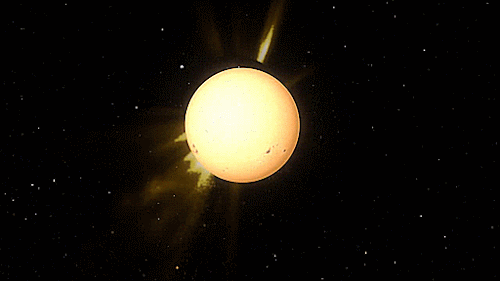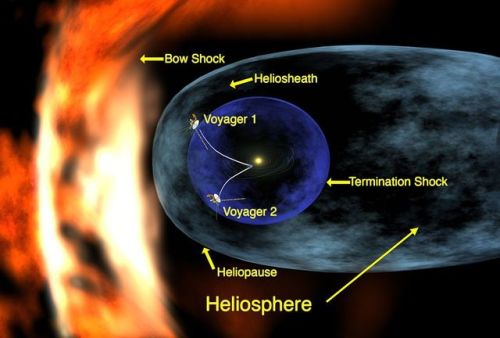Picture Of The Day - February 5, 2019 - (Very Late Post)

Picture of the Day - February 5, 2019 - (Very late post)
I've decided to travel back home in Space Engine.
Earth and the Moon.
More Posts from Sharkspaceengine and Others




The heliosphere is the bubble-like region of space dominated by the Sun, which extends far beyond the orbit of Pluto. Plasma “blown” out from the Sun, known as the solar wind, creates and maintains this bubble against the outside pressure of the interstellar medium, the hydrogen and helium gas that permeates the Milky Way Galaxy. The solar wind flows outward from the Sun until encountering the termination shock, where motion slows abruptly. The Voyager spacecraft have explored the outer reaches of the heliosphere, passing through the shock and entering the heliosheath, a transitional region which is in turn bounded by the outermost edge of the heliosphere, called the heliopause. The shape of the heliosphere is controlled by the interstellar medium through which it is traveling, as well as the Sun and is not perfectly spherical. The limited data available and unexplored nature of these structures have resulted in many theories. The word “heliosphere” is said to have been coined by Alexander J. Dessler, who is credited with first use of the word in the scientific literature.
On September 12, 2013, NASA announced that Voyager 1 left the heliopause on August 25, 2012, when it measured a sudden increase in plasma density of about forty times. Because the heliopause marks one boundary between the Sun’s solar wind and the rest of the galaxy, a spacecraft such as Voyager 1 which has departed the heliosphere, can be said to have reached interstellar space. source
Pillowfort reopens new user registrations at 10 am est
Pillowfort has finally reopened new user registrations which will begin at 10 am eastern. There is a small $5 fee until the site is no longer in beta. I have permanently switched all my posts over there. I’ll be posting a follow up post with my blog link later today






O’Sirus System - Post 4 (Rings)
Two planets in the O’Sirus System have rings, the 7th and 10th planets respectively.
The 7th planet is an ice-world with a thick icy crust floating on a sub-surface ocean. It is roughly 0.30 Earth-masses, has a radius 75% that of Earth and orbits 1.32 AU from the sun. The surface has a carbon dioxide atmosphere of approximately the same pressure as the atmosphere of Mars and surface temperatures of 133 K or -224 °F.
The 10th world is small ice giant 10.5 times more massive than Earth, has a radius 2.8 times larger than Earth and orbits at a distance of 6.02 AU. This world also has a pronounced ring system.
High Resolution Pics
Picture 1 - The 7th Planet
Picture 2 - Ring Closeup
Picture 3 - Another Closeup
Picture 4 - The 10th Planet
Picture 5 - Closeup
Picture 6- Ring Transit
Dry Desert World

2nd Picture of the Day - October 15, 2018
A Mars-Like desert world covered in dunes of iron oxide dust. A small satellite crosses the face of the planet.

Water ice clouds on Mars (desktop/laptop) Click the image to download the correct size for your desktop or laptop in high resolution

Picture of the day 2 - November 23, 2018
Two moons transit in front of a large Titan-Like world with methane oceans.
Space Engine System ID: RS 5581-14-7-1797564-12533 6

Picture of the day - December 7, 2018
Insight B-VI viewed from the surface of its 4th moon.

Picture of the Day 2 - November 9, 2018
Narrow sea cuts through the forests of a life supporting world with red-colored vegetation.
-
 dubbymann liked this · 5 years ago
dubbymann liked this · 5 years ago -
 thekneesofoldtrees liked this · 6 years ago
thekneesofoldtrees liked this · 6 years ago -
 tamarajanegreer liked this · 6 years ago
tamarajanegreer liked this · 6 years ago -
 harmonicgamingangel22blog liked this · 6 years ago
harmonicgamingangel22blog liked this · 6 years ago -
 sharkspaceengine reblogged this · 6 years ago
sharkspaceengine reblogged this · 6 years ago
My Space Engine Adventures, also any space related topic or news. www.spaceengine.org to download space engine. The game is free by the way. Please feel free to ask me anything, provide suggestions on systems to visit or post any space related topic.Check out my other blog https://bunsandsharks.tumblr.com for rabbit and shark blog.
294 posts

![Star Cluster Melotte 15 In The Heart Nebula [IC 1805]](https://64.media.tumblr.com/8b8ffde97e975e9cf7889e2625a4928f/tumblr_pf830p2BAC1vhj0upo1_500.jpg)